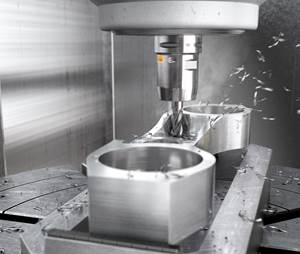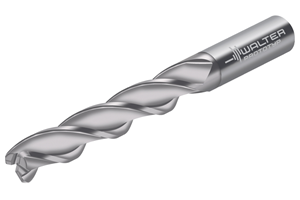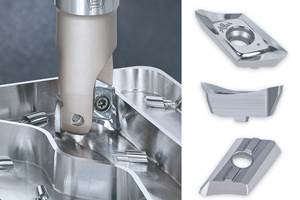Aluminum Welding
The use of aluminum tooling is becoming more common. Choosing the right wire and the right welding technique will produce the most effective mold repair.
Once viewed strictly as a prototype tooling material, aluminum is gaining ground as an option for production molds. In considering this option, it is important to first look at the differences between steel and aluminum, and then determine how best to take advantage of aluminum’s increased thermal conductivity without degradation of part quality. It’s also important to consider issues related to mold repair. Producing a quality part from an aluminum mold is relatively easy, but repairing these molds can pose challenges. To ensure successful repair of an aluminum mold requires an understanding of the differences between steel and aluminum, and the aluminum alloy options, as well as knowledge about welding wire and proper welding techniques.
Aluminum vs. Steel
The high-strength aluminum alloys available today are feasible alternatives to steel for tooling. Originally used primarily for the production of prototypes because of its lower cost, aluminum offers several other advantages that make it a viable option for production molds.
First and foremost, aluminum molds can cost as little as approximately half of what steel molds cost, and it can be delivered in about half the time, thanks to various key material characteristics. For example, although steel is considerably stronger than aluminum, aluminum weighs only one-third as much, and some aluminum materials can be treated to produce strength comparable to steel. Because aluminum is softer than steel, it is easier to cut. The combination of high strength and low weight makes aluminum attractive for use in a variety of industries, including aerospace, automotive and industrial.
Another advantage of aluminum over steel is its high resistance to corrosion. When aluminum is exposed to air, a thin layer of aluminum oxide forms, providing increased protection against corrosion. Additionally, aluminum does not become brittle with decreasing temperatures as steel does. It actually increases in tensile strength and retains toughness.
Aluminum is known to conduct heat and electricity about six times better than steel, and its higher thermal conductivity plays a critical role in welding and mold repair, resulting in welds that solidify faster. This also contributes to a more “practical” weld, better holding the metal in position and easing onsite repair. High thermal conductivity means that heat energy applied to one section of the metal will transfer quickly to other sections. This allows the material to retain stability while withstanding higher temperatures. To avoid degradation of part quality, however, aluminum requires welding with a more intense heat at a faster rate, because the heat is withdrawn rapidly.
Alloy Options
If you opt to use aluminum for your next mold project, it’s important to select the appropriate aluminum alloy. Alloys are created when elements including copper, magnesium and zinc are added to the base aluminum. Each added element contributes individual beneficial properties that will improve the aluminum.
There are two main classifications for aluminum alloys: wrought and cast. Wrought alloys are initially cast as billets and then are mechanically worked through hot or cold methods such as rolling, forging, extrusion and forming to achieve the desired forms. Rolling is used to produce aluminum sheets, foil or plates; forging is used to produce complex shapes with superior properties, and extrusion is used to produce tubes or rods. Cast alloys are directly cast into the desired form, making them well-suited for applications involving complex shapes.
Wrought and cast alloys are further categorized as heat-treatable and non-heat-treatable. Heat-treatable alloys contain alloying elements that will increase the material’s strength and solubility through heat treatment, but the heat-affected zone (HAZ) typically will not be fully annealed, which can impact the strength of any weld. Non-heat-treatable alloys are strengthened through cold-working methods.
These classifications are important considerations in regards to the weldability and repair of the aluminum alloy mold. Certain materials are better-suited to particular welding processes, so the welding method must also be taken into account as the moldmaker decides on the optimal material.
Some of the most commonly used production aluminum alloys come from the 7000-series family. These alloys are attractive to molders because they generally possess high strength that is comparable to steel, and they are more durable than other series. Zinc is the primary alloying element in these aluminum alloys, and this, in combination with other elements such as magnesium and copper, contributes to making them among the strongest alloys at ambient temperatures. The addition of zinc also makes the aluminum heat-treatable, which allows for precipitation hardening, a heat technique used to increase yield strength. Through precipitation hardening, 7000 series alloys can reach tensile strength as high as 700 MPa (megapascals), the highest among all aluminum alloys. Heat treating is most effective after the alloying elements have been dispersed through rolling and forging. The combination of all three processes will build up the properties required of high-strength aluminum. Although 7000-series alloys offer good fatigue strength and machinability, they are less corrosion-resistant than other aluminum alloys, making them susceptible to stress-corrosion cracking and, in turn, difficult to weld.
Other popular choices for production mold applications are alloys from the 2000, 5000 and 6000 series. Those in the 2000 series, like the 7000 series, can be precipitation-hardened to strengths similar to steel through the addition of copper, but alloys in the 2000 series offer lower corrosion resistance, making them even more vulnerable to stress-corrosion cracking than those in the 7000 series. Many 2000-series alloys are considered non-weldable because of this vulnerability.
Alloys in the 5000 series feature the addition of magnesium, which provides for solid solution strengthening and improved strain-hardening, giving them the highest non-heat-treatable strength among aluminum alloys. Because of these qualities, however, 5000-series alloys are among the most difficult and expensive to extrude. They are mainly fabricated as sheets and plates, and only occasionally used as a molding option.
Aluminum in the 6000 series are alloyed with magnesium and silicon, creating heat-treatable, strong and easily extruded alloys with good corrosion resistance. While 6000-series alloys are among the most commonly used for general-purpose applications, they cannot reach the high strengths of those in the 2000 and 7000 series.
These other alloy families are typically produced by the same mills making billets for the 7000-series alloy families, however they are not rolled, forged and heat-treated for strength. Instead, these alloys are directly cast into their final form, allowing them to derive their properties, including strength and weldability, from their alloy composition rather than through the manufacturing process. Because cast alloys do not need to first be rolled or forged into plates or sheets, they can be more economically used for complex product shapes. They will not, however, possess the same level of strength as their rolled or forged counterparts. Cast alloys are a popular choice for prototype production because they cost about half of what a 7000-series alloy costs, and for a prototype, a weaker alloy is acceptable. A modified 2000-series alloy also is available in rolled or forged form, offering a good balance between strength and welding characteristics. Both forms of alloys are readily weldable as per their individual properties.
The desirable qualities inherent in each series of alloys will determine the production applications for which they are best suited. Because of their high strength, 7000-series alloys are most commonly used for high-performance applications such as aerospace, armored vehicles and sporting equipment. The comparably strong 2000-series alloys are most often used for aircraft or aerospace applications, while 5000-series alloys are more weldable and provide non-heat-treatable strength, making them useful for a variety of structural applications such as bridges, buildings, truck or train bodies, shipbuilding, and pressure vessels. Alloys in the 6000 series are the easiest and most economical to extrude, making them suitable for welding as well as for a wide range of extruded shapes.
Welding Wire Options
Different aluminum alloys require differing welding wires in order for successful welding to be achieved. Characteristics of the wire should match those of the specific alloy on which it will be welded, and the wire’s color-matching ability, strength and effect on HAZ should also be considered. Additionally, the welding wire must have a melting temperature similar to that of its base material in order for the most effective welding to occur. For example, aluminum alloys with higher concentrations of magnesium should be welded with a filler alloy that also contains higher levels of magnesium. Each category of welding wire contains its own dynamic chemical makeup that will yield more efficient results with an aluminum alloy that has similar characteristics. In addition to increasing production efficiency, welding deformation should decrease.
Repair of production molds made of several of the 7000-series alloys are challenging because their susceptibility to hot cracking or stress-corrosion cracking makes these alloys unweldable using arc welding techniques. Exceptions to this rule are 7003 and 7005 extrusion alloys and 7039 plate alloy. Welding of qualifying 7000-series alloys can be done using 5356 or 2319 alloy welding wire, both of which can produce porosity-free welds of acceptable strength that can match the aluminum alloy’s integrity. The more commonly used of these welding wires is 5356, because it is rigid and offers acceptable strength and continuous feeding, while 2319 is heat-treatable and provides high strength and good ductility. The 5356 wires also have a 5-percent-magnesium content filler, which reduces the sensitivity to weld cracking. The higher the amount of magnesium, the lower the risk of cracking.
Two mills that produce 7000-series aluminum alloys have helped develop a proprietary alloy welding wire that is designed to work well with 7000-series alloys. These products are not widely available yet, but all early testing results show improved color matching over the 2319 and 5356 wires. The HAZ around the weld repair area that is common to all heat-treated alloys during repair remains an issue with these new wires, however.
The 2319 wire is best-suited for welding of molds made from 2000-series alloys. Wrought 2000-series alloys can be heat-treated to achieve their high tensile strength, which can range to as high as about 448 MPa. They are alloyed with copper, which helps produce much better welding characteristics. Testing has shown that 2319 wire yields outstanding weld quality and color matching, making it the most popular option when color match is of great importance. Alloys in the 2000 series, because of their high aging and tempering, are also more resistant to thermal fatigue than their 7000-series counterparts, meaning that the heat from the weld will not cause a loss in strength of the material being welded.
Alloys in the 6000 series are heat-treatable wrought alloys that show an HAZ around welded areas. The appropriate wire for welding 6000-series aluminum alloys is 4043, which is one of the most manageable, and has a lower melting point and better fluidity, making it less sensitive to weld cracking. This wire type is suited for applications in which strength of the welded area and color matching are most critical. If the parent material will be anodized after repair however, 5356 welding wire is a better option and will produce a much closer color match, because 4043 will turn dark gray after anodizing.
Because cast alloys offer a stronger grain structure while wrought alloys are more porous, they are more likely to exhibit stronger welding repair. A good choice for 5000-series aluminum alloys is 5356 welding wire, while 2319 wire is suited for 2000 series alloys. These wires produce the best color match with the alloys because they possess lower silicon content, maintaining a silver anodized color that blends in well, rather than a black color that is obvious and unattractive. As non-heat-treated products, cast alloys show no HAZ around the weld, so the welded area is not visible on the finished surface of the mold.
Repair Techniques
Once the proper wire has been selected, focus must shift to the proper technique for mold alloy to be welded. This is the largest contributor to a successful weld repair. A proper technique involves more than the actual welding; it must also take into account ambient conditions and preheating of the material, which will remove condensation and increase its weldability.
Typically, alternating current (AC) is used for welding aluminum, however direct current (DC) can produce better results in repairing mold alloys. AC and DC refer to the polarity of the electrical current as it runs through the electrode. Selecting an electrode with the appropriate polarity will have a significant impact on the strength and quality of a weld.
As mentioned earlier, when aluminum is exposed to air, a thin layer of aluminum oxide forms. If this oxide layer is not removed, proper weld fusion and fluidity will be negatively affected. To remove this layer requires a much higher temperature than the temperature required to melt the base aluminum. Alternating current flows in one direction for half the time and in the other direction for the second half. Because AC changes polarity so often (120 times per second with a 60-Hz current), the oxide layer is removed first, enabling the base metal to then melt and fuse more quickly. For best results, an equal and balanced current in both directions is needed.
Direct current flows in only one direction, creating constant polarity. A DC pulse weld, in which the arc pulses between a high peak and low background current, will narrow the HAZ and the heat applied to the parent material, preserving the metal’s original properties. Using an AC pulse weld exposes the welded area to greater porosity as well as poor color match. Porosity occurs when gases become entrapped by welding turbulence when too low of a welding current is used. On aluminum, welding should be performed at a quick rate in order to prevent heat from penetrating into the parent block. If it is performed too slowly, the risk of excessive burn-through increases.
As the use of aluminum tooling increases, piece-part costs will decrease, and this in turn will make the use of aluminum tooling even more common. Selecting optimal welding wires and techniques will make potentially difficult processes easier and provide superior welding results.
Clinton Aluminum and Stainless Steel
Related Content
Technology Review and Sourcing Guide 2024: Mold Materials
Building a high-quality mold requires the proper selection of appropriate mold materials. Tool steel, aluminum, copper and alloys are a just a few examples you can fin in this exclusive, online-only content that includes a supplier list for mold materials.
Read MoreRoughing, Finishing Aluminum-Specific End Mill Line Expansion
Extended range of Sandvik Coromant’s CoroMill Dura versatile solid end mills engages stable cutting, small burr, good surfaces and minimal vibration.
Read MoreSolid Carbide Cutter Mills Aluminum
Roughing and finishing deep pockets and cavities are the primary feature strengths behind this Walter MC166 Advance cutting tool.
Read MoreAluminum Machining Efficiency Improved With Milling Inserts
The TungAluMill line has been enhanced with 10 new XVCT-AM inserts, featuring an interface design that augments machining at high speed rates.
Read MoreRead Next
Reasons to Use Fiber Lasers for Mold Cleaning
Fiber lasers offer a simplicity, speed, control and portability, minimizing mold cleaning risks.
Read MoreHow to Use Strategic Planning Tools, Data to Manage the Human Side of Business
Q&A with Marion Wells, MMT EAB member and founder of Human Asset Management.
Read MoreHow to Use Continuing Education to Remain Competitive in Moldmaking
Continued training helps moldmakers make tooling decisions and properly use the latest cutting tool to efficiently machine high-quality molds.
Read More




















